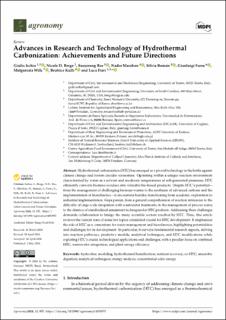Please use this identifier to cite or link to this item:
https://doi.org/10.21256/zhaw-30600Full metadata record
| DC Field | Value | Language |
|---|---|---|
| dc.contributor.author | Ischia, Giulia | - |
| dc.contributor.author | Berge, Nicole D. | - |
| dc.contributor.author | Bae, Sunyoung | - |
| dc.contributor.author | Marzban, Nader | - |
| dc.contributor.author | Román, Silvia | - |
| dc.contributor.author | Farru, Gianluigi | - |
| dc.contributor.author | Wilk, Małgorzata | - |
| dc.contributor.author | Kulli Honauer, Beatrice | - |
| dc.contributor.author | Fiori, Luca | - |
| dc.date.accessioned | 2024-05-08T13:14:13Z | - |
| dc.date.available | 2024-05-08T13:14:13Z | - |
| dc.date.issued | 2024-05-02 | - |
| dc.identifier.issn | 2073-4395 | de_CH |
| dc.identifier.uri | https://digitalcollection.zhaw.ch/handle/11475/30600 | - |
| dc.description | Review | de_CH |
| dc.description.abstract | Hydrothermal carbonization (HTC) has emerged as a pivotal technology in the battle against climate change and fosters circular economies. Operating within a unique reaction environment characterized by water as a solvent and moderate temperatures at self-generated pressures, HTC efficiently converts biomass residues into valuable bio-based products. Despite HTC’s potential— from the management of challenging biomass wastes to the synthesis of advanced carbons and the implementation of biorefineries—it encounters hurdles transitioning from academic exploration to industrial implementation. Gaps persist, from a general comprehension of reaction intricacies to the difficulty of large-scale integration with wastewater treatments, to the management of process water, to the absence of standardized assessment techniques for HTC products. Addressing these challenges demands collaboration to bridge the many scientific sectors touched by HTC. Thus, this article reviews the current state of some hot topics considered crucial for HTC development: It emphasizes the role of HTC as a cornerstone for waste management and biorefineries, highlighting potentialities and challenges for its development. In particular, it surveys fundamental research aspects, delving into reaction pathways, predictive models, analytical techniques, and HTC modifications while exploring HTC’s crucial technological applications and challenges, with a peculiar focus on combined HTC, wastewater integration, and plant energy efficiency. | de_CH |
| dc.language.iso | en | de_CH |
| dc.publisher | MDPI | de_CH |
| dc.relation.ispartof | Agronomy | de_CH |
| dc.rights | https://creativecommons.org/licenses/by/4.0/ | de_CH |
| dc.subject | Hydrochar | de_CH |
| dc.subject | Modeling | de_CH |
| dc.subject | Hydrothermal humification | de_CH |
| dc.subject | Nutrient recovery | de_CH |
| dc.subject | Anaerobic digestion | de_CH |
| dc.subject | Analytical technique | de_CH |
| dc.subject | Energy analysis | de_CH |
| dc.subject | co-HTC | de_CH |
| dc.subject | Review | de_CH |
| dc.subject.ddc | 660: Technische Chemie | de_CH |
| dc.title | Advances in research and technology of hydrothermal carbonization : achievements and future directions | de_CH |
| dc.type | Beitrag in wissenschaftlicher Zeitschrift | de_CH |
| dcterms.type | Text | de_CH |
| zhaw.departement | Life Sciences und Facility Management | de_CH |
| zhaw.organisationalunit | Institut für Umwelt und Natürliche Ressourcen (IUNR) | de_CH |
| dc.identifier.doi | 10.3390/agronomy14050955 | de_CH |
| dc.identifier.doi | 10.21256/zhaw-30600 | - |
| zhaw.funding.eu | No | de_CH |
| zhaw.issue | 5 | de_CH |
| zhaw.originated.zhaw | Yes | de_CH |
| zhaw.pages.start | 955 | de_CH |
| zhaw.publication.status | publishedVersion | de_CH |
| zhaw.volume | 14 | de_CH |
| zhaw.publication.review | Peer review (Publikation) | de_CH |
| zhaw.webfeed | Bodenökologie | de_CH |
| zhaw.funding.zhaw | HTC Innovationscampus Rheinmühle - Pilotanlage zur Hydrothermalen Karbonisierung | de_CH |
| zhaw.author.additional | Yes | de_CH |
| zhaw.display.portrait | Yes | de_CH |
| Appears in collections: | Publikationen Life Sciences und Facility Management | |
Files in This Item:
| File | Description | Size | Format | |
|---|---|---|---|---|
| 2024_Ischia-etal_Advances-hydrothermal-carbonization_agronomy.pdf | 3.48 MB | Adobe PDF |  View/Open |
Show simple item record
Ischia, G., Berge, N. D., Bae, S., Marzban, N., Román, S., Farru, G., Wilk, M., Kulli Honauer, B., & Fiori, L. (2024). Advances in research and technology of hydrothermal carbonization : achievements and future directions. Agronomy, 14(5), 955. https://doi.org/10.3390/agronomy14050955
Ischia, G. et al. (2024) ‘Advances in research and technology of hydrothermal carbonization : achievements and future directions’, Agronomy, 14(5), p. 955. Available at: https://doi.org/10.3390/agronomy14050955.
G. Ischia et al., “Advances in research and technology of hydrothermal carbonization : achievements and future directions,” Agronomy, vol. 14, no. 5, p. 955, May 2024, doi: 10.3390/agronomy14050955.
ISCHIA, Giulia, Nicole D. BERGE, Sunyoung BAE, Nader MARZBAN, Silvia ROMÁN, Gianluigi FARRU, Małgorzata WILK, Beatrice KULLI HONAUER und Luca FIORI, 2024. Advances in research and technology of hydrothermal carbonization : achievements and future directions. Agronomy. 2 Mai 2024. Bd. 14, Nr. 5, S. 955. DOI 10.3390/agronomy14050955
Ischia, Giulia, Nicole D. Berge, Sunyoung Bae, Nader Marzban, Silvia Román, Gianluigi Farru, Małgorzata Wilk, Beatrice Kulli Honauer, and Luca Fiori. 2024. “Advances in Research and Technology of Hydrothermal Carbonization : Achievements and Future Directions.” Agronomy 14 (5): 955. https://doi.org/10.3390/agronomy14050955.
Ischia, Giulia, et al. “Advances in Research and Technology of Hydrothermal Carbonization : Achievements and Future Directions.” Agronomy, vol. 14, no. 5, May 2024, p. 955, https://doi.org/10.3390/agronomy14050955.
Items in DSpace are protected by copyright, with all rights reserved, unless otherwise indicated.